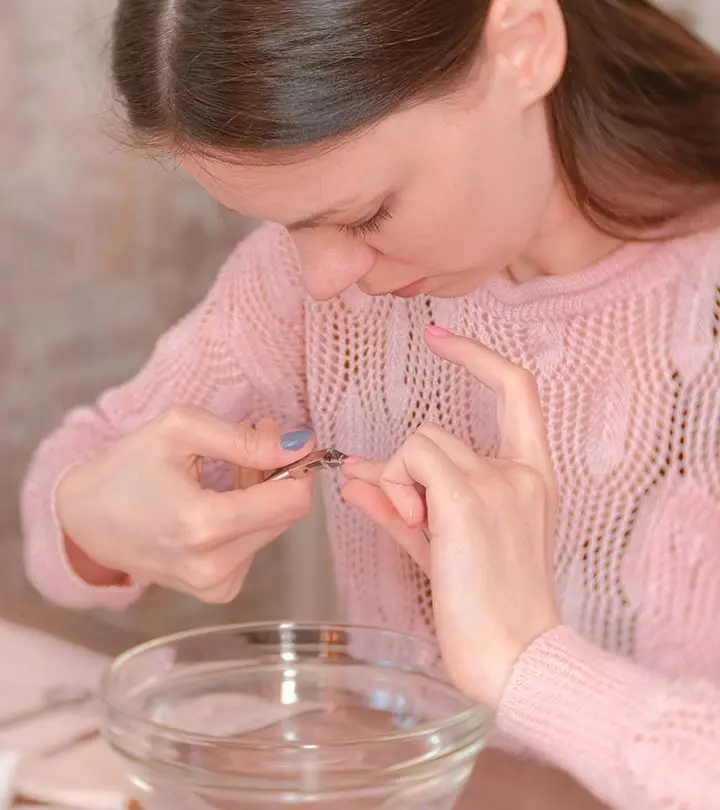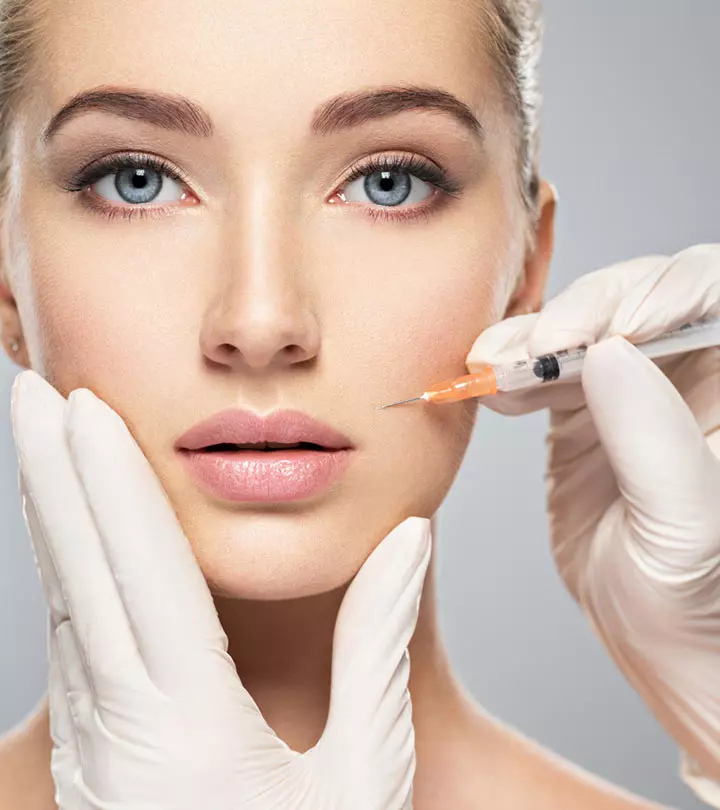Sebaceous Filaments: 5 Expert Tips To Minimize Their Appearance
Everything you need to know about these reappearing facial spots and how to manage them.

Image: Shutterstock
You might have noticed dark spots on your face and looked up for blackhead removal options. What if we say not all of them are blackheads? Yes, they can be sebaceous filaments. People often confuse sebaceous filaments with blackheads and try removing them. But no matter how much you squeeze, they will come back.
These occur naturally on everyone’s skin. However, some have more noticeable sebaceous filaments compared to others.
This article explores more about sebaceous filaments and how you can manage them. Keep reading to learn more.
In This Article
What Are Sebaceous Filaments?
Sebaceous filaments are structures present naturally in your skin.
They are a tube-like material lining the walls of your pores (1). The nose and cheeks are common areas on your skin where you may notice sebaceous filaments.
The pores on your skin produce an oily substance called sebum to moisturize the skin and protect it against environmental elements. The oil fills the pores to become sebaceous filaments. The purpose of these filaments is to guide the oil to the surface of the skin, where it can protect and nourish your skin.
Sebaceous filaments are typically invisible. But when the sebum production increases, oil starts to build up within the pores and eventually hardens. It can stretch your pore and spill out of your skin. Only then will you be able to see those small grayish-yellow dots along your skin.
 Trivia
TriviaSebaceous filaments usually take around 30 days to fill up the pores, even lesser for oily skin.
Learn what causes these skin formations in the next section.
Key Takeaways
- Sebaceous filaments are tube-like structures that allow sebum to go to the skin surface to nourish it.
- You can use glycolic acid, tea tree oil, and salicylic acid to cleanse your pores and reduce the appearance of sebaceous filaments over time.
- Washing your face with a mild cleanser, exfoliating your face once a week, and eating a balanced diet can prevent sebaceous filaments from being visible.
What Are The Causes Of Sebaceous Filaments?

When your skin produces excess sebum, it can make the sebaceous filaments more visible. People with oily skin or larger pores are more likely to have visible sebaceous filaments on the skin, unlike those with smaller pores or dry skin.
Some factors that may influence the type of your skin and how visible these sebaceous filaments include:
- Age
- Genetics
- Exposure to the sun and other pollutants
- The thickness of hair follicles
While sebaceous filaments look a lot like blackheads, they are not the same.
Understanding the nuances of sebaceous filaments vs blackheads is key to effectively treating each condition and maintaining a clear complexion.
Check out their differences in the next section.
Sebaceous Filaments Vs. Blackheads
We know oily skin, large pores, and excess sebum production makes your sebaceous filaments more visible. That is why most people confuse them with blackheads.
One of the differentiating factors between sebaceous filaments and blackheads is their color. While the filaments have a gray or yellow color, blackheads are obviously black.
Blackheads are a result of sebum, dead skin cells, and bacteria accumulating in the pores and clogging them. This causes bumps to appear on your skin called comedones. When it remains exposed to the air for some time, it turns black.
Sebaceous filaments, on the other hand, are simply the oil lining the pores. You can develop blackheads through sebaceous filaments.
Note: Be it a blackhead or a sebaceous filament, never tease or squeeze it.
 Trivia
TriviaSebaceous filaments or sebum plugs can turn into whiteheads and cysts later.
Now that you know the difference between these two skin formations, let’s find out how to treat sebaceous filaments.
How Do You Treat Sebaceous Filaments?
1. Leave Them Alone
Sebaceous filaments are natural. The pores keep lining up with them, and any attempt at removal is a losing battle. Squeezing these filaments can instead harm your skin. You will put yourself at risk of scarring and skin infections by picking or squeezing your skin. Therefore, it is best to leave them alone.
2. Minimize Their Appearance

Rather than squeezing the sebaceous filaments, you can control the oiliness of your skin. Regular cleansing and exfoliating can control the amount of oil secretion and keep your pores clear and healthy. While skin care products will not completely eliminate the visible filaments, you can help minimize their appearance.
You can opt for gentle products that prevent dehydration and irritation. When choosing skin care and beauty products, always ensure they suit your skin type.
If you are wondering how to unclog your skin pores and minimize sebaceous filaments, there are several effective techniques to explore. Skin care ingredients that fight acne may help you minimize the appearance of sebaceous filaments:
Salicylic Acid
Salicylic acid is an essential ingredient in many facial cleansers and acne creams. A concentration of 0.5-2% salicylic acid reduces the amount of oil on your skin and minimizes the size of sebaceous filaments on your face through exfoliation. According to dermatology experts, peels with salicylic acid are more effective as they have a higher concentration than over-the-counter products (2).
Caution: Salicylic acid is a product of aspirin. If you are allergic to aspirin, there is a high chance you are allergic to salicylic acid as well. Always do a patch test before using any product with salicylic acid.
Glycolic Acid

Glycolic acid is an alpha hydroxy acid. It can clear your pores and prevent blackheads (3). It may also help reduce the appearance of sebaceous filaments. While salicylic acid can increase the dryness of your skin, glycolic acid retains its moisture.
Caution: Glycolic acid can trigger an allergic reaction in some people, leading to swelling and itching. It is also known to increase the sensitivity of your skin to sunlight. Always apply sunscreen after using any skin care product with glycolic acid.
Benzoyl Peroxide
Benzoyl peroxide is another common ingredient in acne products. It limits the oil secretion of your skin and may reduce the size of pores (4).
Caution: At higher concentrations, benzoyl peroxide can dry out your skin, causing it to peel. Either opt for products with lower concentrations or avoid using benzoyl peroxide altogether if you experience skin peeling and dryness.
Tea Tree Oil

Several skin care experts vouch for the anti-acne effects of tea tree oil. It can also assist in oil control (5). Thus, it may help in reducing sebaceous filaments.
Caution: Some people experience trouble with skin irritation and allergic reactions after using tea tree oil. If you plan to use tea tree oil as part of your skin care regimen, remember to dilute it down to 5% strength.
Face Masks
Many face masks and sheet masks help deep cleanse your facial skin. These masks contain activated charcoal or clay that draw out any impurities from the skin that could be clogging the pores – bacteria, dead skin cells, oil, or dirt. You can also consider making your own face masks as a budget home remedy. Use natural ingredients like apple cider vinegar and clay as they are known to exfoliate the skin, clear out pores, and regulate oil production. Add a bit of honey to the mix for moisturization.
Caution: Although these masks are generally safe to use, if they are left in for too long on the skin, they can irritate your skin and cause redness and itchiness.
3. Sun Protection

Prolonged sun exposure may expand your pores. Large pores can lead to visible sebaceous filaments. Regular use of sunscreen can reduce the harmful effects of the sun and retain your skin health.
Keep your skin type in mind when choosing a sunscreen. If your skin is oily or prone to breakouts, choose a non-comedogenic and oil-free sunscreen. To prevent sun exposure, you can also cover your face with a hat and wear full-sleeved clothes.
4. Pore Strips
may help extract some of the oil, dirt, and debris from the pores and make them less noticeable. However, they only provide a temporary solution and may not totally eliminate sebaceous filaments. Furthermore, frequent or improper use of pore strips may cause skin irritation and redness and further exacerbate the issue.
5. Pore Vacuums
Pore vacuums are designed to extract debris, oil, and sebum from the pores, and may also help remove sebaceous filaments. However, their effectiveness depends on your skin type and the specific device being used. While they may provide temporary relief, pore vacuums may not eliminate the filaments as they tend to naturally refill over time. Also, excess use of pore vacuums can lead to skin irritation, bruising, and broken capillaries.
You can also try oil cleansing. Doro, a vlogger, tried the oil cleansing method for 30 minutes. She recommends using a natural, non-comedogenic oil, like grapeseed, almond, or rosehip seed oils, over a commercial cleansing oil. This helps reduce skin irritations that might occur during the process. She explains the principle behind this process, saying, “So when you apply oil on your skin and massage it for about 20 minutes, it’s supposed to attract and then pull out all the sebum impurities and gunk stuck in your pores in a very gentle, painless way (i).” After 20 minutes, she washed off the oil with a mild cleanser and applied moisturizer. Her first impression was that her skin was soft but also a bit sensitive.
Maintaining a healthy skin care routine can help prevent your pores from clogging. Find out all about the right regimen to keep these filaments at bay in the next section.
How To Prevent Sebaceous Filaments
Here are some ways through which you can prevent visible sebaceous filaments on your skin:
- Wash and moisturize your face twice a day with a mild cleanser.
- Exfoliate your skin once a week.
- Use a face mask at least once a week.
- Maintain a healthy diet that is rich in fruits and vegetables.
- If your skin is prone to breakouts, consult a dermatologist regularly to ensure you are using the right products for your skin.
Next, let’s see if you can develop any unwanted side effects or complications from these filaments.
Complications Of Sebaceous Filaments
Sebaceous filaments rarely lead to any complications.
However, some people may develop sebaceous gland carcinoma anywhere on their body. The tumors look like yellow lumps that are firm to touch. They typically occur in older people and can be present on the face, neck, eyelids, and trunk. These lumps need surgery to be removed (6).
When Should You See A Doctor For Sebaceous Filaments?
Are you following a proper skin care routine with all the right products but still facing trouble with sebaceous filaments on your nose and other parts of your face?
If so, it would be wise to consult a dermatologist. They can prescribe you more effective treatments to help with oil control and reduce the visibility of your sebaceous filaments.
Infographic: Skin Care Routine To Prevent Sebaceous Filaments
Sebaceous filaments are naturally present in your skin and only become visible when there is excess oil buildup. The good news is that a good skin care routine can help manage them. Using the right products can decrease the possibility of visible filaments, keep your pores tight, and smoothen your skin. In the infographic below, we have shareed a specific skin care routine that can help prevent sebaceous filaments. Check it out!
Some thing wrong with infographic shortcode. please verify shortcode syntaxSebaceous filaments are tube-like structures lining the walls of your pores. Though they appear like blackheads, they are not the same. Enlarged pores, excess sebum production, oily skin, exposure to sun and pollutants, and thickness of hair follicles make these sebaceous filaments more visible.
If they are visible, you can adopt some of the ways mentioned in the article to improve their appearance. Cleansing, exfoliating, and moisturizing are simple ways that help clear these. You can also consult your doctor to determine which products may suit your skin.
Frequently Asked Questions
Is Retinol Good for sebaceous filaments?
Topical retinoids are essential for treating acne because they fight against comedones and microcomedones and have anti-inflammatory properties (7). Hence, they also may help reduce sebaceous filaments. However, those with sensitive skin can introduce them into their skin care routine once a week and slowly increase the frequency.
Do sebaceous filaments reduce on their own?
Sebaceous filaments are a natural part of your and cannot be removed. While big sebaceous filaments can be retrieved professionally, the removal is just temporary—they constantly reappear.
Can I extract sebaceous filaments?
No, you should not extract sebaceous filaments. It can irritate the skin and may lead to inflammation or infection. Focus on a healthy skincare routine, and use non-comedogenic products and gentle exfoliators to keep a check on oil production.
Discover the truth about sebaceous filaments and how to manage them effectively. Watch this informative video that explores the causes, prevention, and treatment options for a clearer and smoother complexion.
Personal Experience: Source
StyleCraze's articles are interwoven with authentic personal narratives that provide depth and resonance to our content. Below are the sources of the personal accounts referenced in this article.
i. I tried oil cleansing for 30 minutes & this happened! *before & after results*,https://www.youtube.com/watch?v=PYsNBjv7U2U
References
Articles on StyleCraze are backed by verified information from peer-reviewed and academic research papers, reputed organizations, research institutions, and medical associations to ensure accuracy and relevance. Read our editorial policy to learn more.
- Sebaceous filaments
https://europepmc.org/article/med/130839 - Salicylic acid as a peeling agent: a comprehensive review
https://www.ncbi.nlm.nih.gov/pmc/articles/PMC4554394/ - Glycolic acid peel therapy – a current review
https://www.ncbi.nlm.nih.gov/labs/pmc/articles/PMC3875240/ - Benzoyl Peroxide
https://www.ncbi.nlm.nih.gov/books/NBK537220/ - Efficacy and safety of tea tree oil as a topical antimicrobial agent
https://www.sciencedirect.com/science/article/abs/pii/S0195670198901359 - Sebaceous Gland Carcinoma
https://www.ncbi.nlm.nih.gov/books/NBK562223/ - Topical retinoids in acne–an evidence-based overview
https://pubmed.ncbi.nlm.nih.gov/18479477/
- Sebaceous filaments
- Sebaceous filaments
https://europepmc.org/article/med/130839 - Salicylic acid as a peeling agent: a comprehensive review
https://www.ncbi.nlm.nih.gov/pmc/articles/PMC4554394/ - Glycolic acid peel therapy – a current review
https://www.ncbi.nlm.nih.gov/labs/pmc/articles/PMC3875240/ - Benzoyl Peroxide
https://www.ncbi.nlm.nih.gov/books/NBK537220/ - Efficacy and safety of tea tree oil as a topical antimicrobial agent
https://www.sciencedirect.com/science/article/abs/pii/S0195670198901359 - Sebaceous Gland Carcinoma
https://www.ncbi.nlm.nih.gov/books/NBK562223/ - Topical retinoids in acne–an evidence-based overview
https://pubmed.ncbi.nlm.nih.gov/18479477/
Read full bio of Dr. Priya Gill
Read full bio of Arshiya Syeda
Read full bio of Ramona Sinha
Read full bio of Monomita Chakraborty


























Community Experiences
Join the conversation and become a part of our empowering community! Share your stories, experiences, and insights to connect with other beauty, lifestyle, and health enthusiasts.